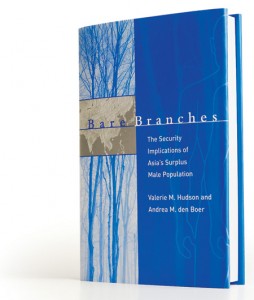A BYU professor says dramatic demographic shifts in Asia portend future security threats.

Nearly a decade ago, while reading about a 19th-century uprising against China’s Qing dynasty in which 100,000 bachelors
banded together to steal, raid, and commit violence, Valerie M. Hudson, ’78, experienced an epiphany that now reverberates worldwide.
Hudson, a political science professor, recalls discussing that account of the 1851–68 Nien Rebellion with Andrea M. den Boer, ’98, who was then her teaching assistant. The two set out on a path of scholarship that would wend its way through China and India before arriving at the 2004 publication of their attention-getting book, Bare Branches: Security Implications of Asia’s Surplus Male Population (MIT Press, 2004).
The decision to start down that path came in the early-morning hours following Hudson’s discussion with den Boer, when Hudson awoke with the title of the book in her head. Though not a demographer or expert on China or India, she felt impressed that it was her duty to pursue this project.
Hudson and den Boer, now a lecturer in international politics at the University of Kent in England, took the title of their book from the Chinese term guang gun-er, long used to describe males who do not have families because they cannot find spouses.
Hudson and den Boer write that in societies with extremely skewed sex ratios, such as China and India, certain “surplus males have little or no bargaining power in the marriage market and thus frequently end up alone” (p. 88). These bare branches share several characteristics: low socioeconomic status, unemployment or underemployment, few ties to the communities in which they look for work, and participation in a distinctive bachelor subculture as social outcasts. Historically, as with the Nien Rebellion, a surplus of males has led to violence, and scholars in India have recently identified a correlation between sex ratios and crime.
Missing Women
The problem of surplus males is rooted in an old and widespread practice among some societies of offspring sex selection, which Hudson and den Boer document in Bare Branches. In almost all cases of sex selection, male children have been preferred.
In Asia the strong preference for sons relates to traditional religious beliefs, social customs, and economic benefits in the form of support for parents in old age. Sex-selective abortion, female infanticide, and neglect of young girls partially explain the huge discrepancy in the number of men and women in Asian countries.
Hudson and den Boer used census data and birth-sex ratios for seven countries—Afghanistan, Bangladesh, China, India, Pakistan, South Korea, and Taiwan—to calculate that there are 90 million “missing women” in those countries, “women (including female infants and girls) who would be alive today in the absence of a gender bias in mortality” (p. 58).
Normal birth-sex ratio is 105-7 boys to 100 girls. Due to higher mortality rates for boys, the ratio levels off by about age 5. In China various sources—including the national government—have reported the birth-sex ratio in the last decade at between 114 and 121 boys to 100 girls. In India the ratio has been reported at between 111 and 114 boys to 100 girls.
Hudson concludes that birth-sex ratios in Asia became exaggerated after the mid-1980s, when the availability of technology such as ultrasound machines began to facilitate sex-selective abortion on a large scale.
The Chinese government, which instituted strict family planning limits in the late 1980s, manufactured portable ultrasound machines that were taken to remote villages, Hudson told a gathering of students at a David M. Kennedy Center lecture in September. Enterprising businesses in India did the same.
In a July Washington Post editorial, Hudson and den Boer explained that it has been about 20 years since the introduction of sex-identification technology, and populations in Asia will grow in coming years. “Conservative estimates [suggest that] the number of young adult bare branches in China in 2020 will be about 30 million, in India about 28 million,” they wrote.
Surplus Males and Social Unrest
Based on historical accounts and empirical data, Hudson and den Boer argue that a surplus of bare branches in China and India, particularly, may lead to increased violence and state authoritarianism as governments crack down on crime. The authors predict that, in part because of large numbers of surplus males, China will have a difficult time developing full democracy while India’s democratic government will face significant challenges to sustain itself.
At a Kennedy Center lecture, Hudson said she cannot predict specific domestic or international strife, but she hopes the conclusions in her book are taken seriously—not only by scholars but also by government officials.
“What I am saying to U.S. security analysts is, ‘Don’t forget that there may come a time when China would prefer its young men go forth in some nationalistic cause rather than stay home,'” she said.
Rose McDermott, an associate professor of political science at the University of California, Santa Barbara, became familiar with Hudson and den Boer’s work when reviewing a manuscript later published in the journal International Security. She says she was struck by the originality and well-placed timing of the research.
“[Hudson] makes a very coherent and convincing argument,” McDermott says. “She points to what is in essence a ticking time bomb. If things aren’t done to address this problem, it will become more severe over time rather than less.”
In the face of such large numbers of surplus males, Hudson and den Boer say the governments of China and India face several options to deal with them: promote the out-migration of bare branches to other countries as guest workers; encourage in-migration of females; equalize income and resources between bare branches and married males; and make efforts to increase society’s valuation of females.
China and India have already banned sex-selective abortion and infanticide. The Chinese government launched a public relations campaign in 1996 to demonstrate that daughters may provide better care for elderly parents than sons. Popular Chinese soap operas, with input from government family-planning authorities, have aired episodes depicting women who refuse to allow their baby daughters to be killed.
Raising an Alarm

Bare Branches has received widespread attention from news media outlets around the world. The book has sparked spirited debate in North America and Europe, as well as Asia. The New York Times reported in July that some scholars dispute the authors’ conclusions. But den Boer, who with Hudson is developing comprehensive worldwide data to bolster the Asia research, is pleased that the issue is being discussed.
“While some have called us alarmists, if raising an alarm helps to avert future problems, then I don’t mind being labeled this way,” den Boer says. “I think the argument in the book has increased interest in the effect of China’s population policies, in particular, and the debate and dialogue that have resulted can only have positive results.”
For Hudson, the most gratifying part of the experience has not been the media attention or professional recognition. Rather, she points to the Chinese government’s July announcement of an incentive program called “Care for Girls,” in which families who keep and raise female infants receive social and economic benefits. Though they don’t take credit for such developments, Hudson and den Boer believe their work has spurred the discussion of these issues in China and heightened their visibility worldwide.
She hopes further government and educational efforts will make a difference.
“Given that almost 40 percent of the world’s population is in China and India,” Hudson and den Boer wrote in the Washington Post editorial, “the likelihood of diminishing prospects for democracy, stability and peace . . . will affect not only Asia but the world.”
Ed Carter is an assistant professor of communications at BYU.









